Fembio Specials Famous Lesbians A.H. Nijhoff
Fembio Special: Famous Lesbians
A.H. Nijhoff

© DVN (Digitaal Vrouwenlexicon van Nederland)
(Birth name: Antoinette Hendrika Wind, Marriage name: Antoinette Hendrika Nijhoff-Wind, Call name: Nettie or Netty)
born June 9, 1897 in The Hague, Netherlands
died March 21, 1971 in The Hague, Netherlands
Dutch writer and translator
125th birthday on June 9, 2022
Biography
Oh, what are facts. They tell no more about someone than washed-up driftwood tells about the ship to which it belonged. It may say something about the identity of the ship and prove its sinking, but what does it tell about the destination of the voyage and the life and death struggle that was fought with the elements in search of the destination.
A. H. Nijhoff
She never met her father Hendrik Jeltinus Wind, who had worked as an engineer laying a railroad line in Venezuela. He was considered missing after a shipwreck on his way back to Europe the year after her birth and was never found. The year before, her mother, Marie Wind-De Bruyne, had returned to the Netherlands from there with her older sister Gerda, who was still a baby. So Netty Wind grew up alone with her mother, a self-sufficient and independent woman, and her sister.
For a while they lived with their mother's parents in Groningen before traveling to Indonesia for a year when Netty Wind was five. They stayed with an aunt in Batavia. For the young girl, these were her first experiences abroad, followed by many more.
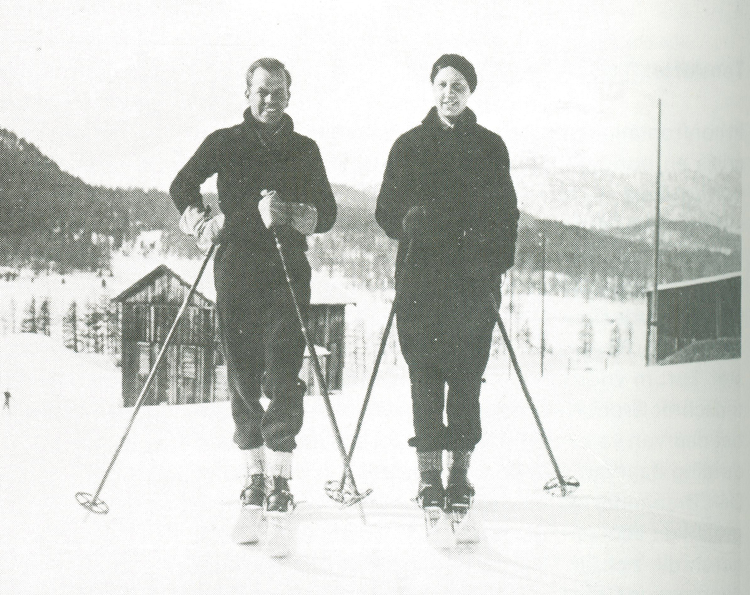 Back in the Netherlands, the three moved to De Bilt (near Utrecht), and a short time later to The Hague, where Netty finished her elementary school years and transferred to the Haganum Gymnasium. Except for Dutch classes, however, she was bored at school and frequently played truant, so she failed to graduate.
Back in the Netherlands, the three moved to De Bilt (near Utrecht), and a short time later to The Hague, where Netty finished her elementary school years and transferred to the Haganum Gymnasium. Except for Dutch classes, however, she was bored at school and frequently played truant, so she failed to graduate.
She knew she wanted to write while she was still at school. At the age of six she was already writing whole notebooks full, and at eight she finished her first novel. During her school years, she published her first works in Rostra gymnasiorium, the newspaper of the National Federation of Grammar Schools.
At a school ball she met the brother of a classmate: the later poet Martinus Nijhoff, called Pom. Both were impressed by each other; the fact that they both wrote connected them.
After her school years, Netty Wind worked for a while for her boyfriend's father in the publishing house of Martinus Nijhoff; again, she was bored. When it became clear in 1916 that she was pregnant, the two married under pressure from his family. That same year their son Stefan, called Faan, was born, and the young family moved to Alkmaar. Their father-in-law had a house built for them in Laren, called De muis, the Mouse, which they moved into in October 1917. The house became a meeting place for many artists, writers and composers, such as A. Roland Holst, Piet Mondrian and Willem Pijper, with whom they had much contact.
As Martinus Nijhoff was traveling more and more, Netty Nijhoff became increasingly bored and went to Paris with her son; however, she remained in friendly contact with her husband. In France she began to write seriously. Her novels Afstand (Distance) and Mister Boy were written there, both of which she probably destroyed.
On a trip through Italy, she met Maria Tesi, who claimed to be a former film actress, and who suggested that they run a guesthouse together. Her Villa Linda in Settignano, near Florence, became a great success; not least because of an advertisement in a Dutch magazine, the guesthouse was very popular from the start. The boarding house involved a lot of work. Nijhoff needed to learn how to cook, there was no money for staff; the two women had to do everything themselves. There was no time left for reading or even writing.
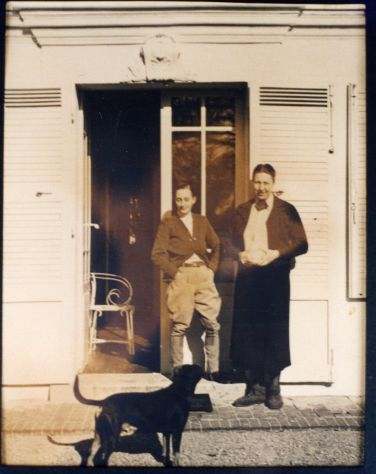 Her father-in-law insisted that his grandson should go to a Dutch school instead of the International School in Florence, which he attended, so Nijhoff moved back to Paris to be closer to him. There, in June 1929, she met her new partner, the British paintress and sculptress Marlow Moss, and they remained together until Moss’s death. The two moved in with Nijhoff's son in Paris, and it was a creative time for both of them. Visits to Cornwall, where Moss had previously lived and still had a studio, were a great inspiration to Nijhoff, and this is reflected in her novels.
Her father-in-law insisted that his grandson should go to a Dutch school instead of the International School in Florence, which he attended, so Nijhoff moved back to Paris to be closer to him. There, in June 1929, she met her new partner, the British paintress and sculptress Marlow Moss, and they remained together until Moss’s death. The two moved in with Nijhoff's son in Paris, and it was a creative time for both of them. Visits to Cornwall, where Moss had previously lived and still had a studio, were a great inspiration to Nijhoff, and this is reflected in her novels.
In Paris, she wrote her novel Twee meisjes en ik (Two Girls and I), first published in the literary magazine De gids in 1930, and in book form a year later. To this day, it continues to be reprinted in the Netherlands, most recently in 2018. Set in a hotel on the southern English coast, the novel is about two young girls and is told from a doctor's point of view; it is about their relationships with each other. Some of the reactions were outrage, saying it would tarnish the Nijhoff name (her father-in-law was a well-known publisher, her husband a respected poet). But A. H. Nijhoff had chosen her own way: a pseudonym with which she was not recognizable as a woman, a novel with allusions to a lesbian relationship, and a man as the main character.
From 1931 to 1937, Nijhoff and Moss lived together in Paris, where they belonged to a circle of international visual artists. In 1937, Moss bought the small country house Chȃteau d'Evreux in Gauciel near Evreux in Normandy, which they remodeled themselves. They furnished it with self-designed furniture and numerous paintings by Moss, Mondrian, Gorin, Van Doesburg and others, and intended to settle there permanently. Among the frequent visitors was above all their son Stefan Nijhoff, when he was not in Paris for his training as a photographer with Man Ray.  But the two women were also frequent visitors to the capital and continued to frequent the legendary lesbian bar Le Monocle - sometimes together with Stefan Nijhoff and his partner, the ballet dancer Albert Mol. Nijhoff translated La porte étroite by André Gide into Dutch during her time in Paris; the translation appeared in 1937 under the title De enge poort.
But the two women were also frequent visitors to the capital and continued to frequent the legendary lesbian bar Le Monocle - sometimes together with Stefan Nijhoff and his partner, the ballet dancer Albert Mol. Nijhoff translated La porte étroite by André Gide into Dutch during her time in Paris; the translation appeared in 1937 under the title De enge poort.
But their happiness in the countryside lasted only a short time. When World War II broke out in 1939, the two women left Gauciel and temporarily moved to the Nijhoff house Antoinette in Biggekerke (on the Walcheren peninsula in the Netherlands). It was a small quiet place, and they hoped to sit out the war there until they could return to their country home in France. This wish did not come true, however, as the Chȃteau was occupied by the French Air Force and completely destroyed by Allied bombing in 1944.
But first, both women were able to successfully continue their work in Biggekerke. Moss managed to escape back to England just in time during the German invasion of the Netherlands.
After the Dutch surrender, Nijhoff slipped into depression; she felt like a stranger, a fugitive; to her it was a forced retreat. She spent the first two years of the war essentially withdrawn and alone. She saw hardly anyone and threw herself into her work. She wrote a lot; it was her only occupation.
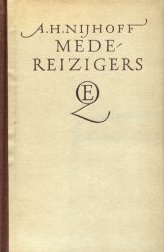 In 1942, a volume of stories by her appeared under the title Medereizigers (Fellow Travelers), although it only came out after pressure from her publisher. This book, dedicated to her son, contains four stories that deal with existentialist questions, such as the question of the (im)possibility of freedom and the goal of art. The main character in all the stories is again a man, Philip, who is always a naive young spectator. Included in this volume is the only story by Nijhoff that has appeared in German translation, Archie.
In 1942, a volume of stories by her appeared under the title Medereizigers (Fellow Travelers), although it only came out after pressure from her publisher. This book, dedicated to her son, contains four stories that deal with existentialist questions, such as the question of the (im)possibility of freedom and the goal of art. The main character in all the stories is again a man, Philip, who is always a naive young spectator. Included in this volume is the only story by Nijhoff that has appeared in German translation, Archie.
At the beginning of 1942, the house in Biggekerke was seized by Germans; there were only twelve hours to vacate it. Nijhoff moved in with her son in Ginneken near Breda, where he had a photo studio and worked under the artist name Stephen Storm, and there she had to get used to the inhabited world again. It was tiring for her to have visitors coming all the time, like her mother, sister and aunt, but also friends. Life seemed frighteningly boring to her, even though she lived at the same time with the fear of losing it every day. Despite everything, however, she managed to continue working there.
After the war, she didn't know where her home was for a while, she could hardly stand it in the Netherlands, tried to get in touch with Marlow Moss, but they couldn't meet again until 1947 in Paris.
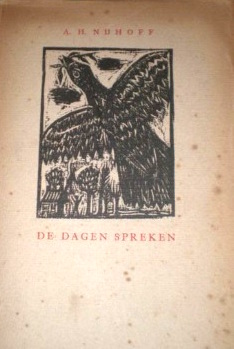 During this time, she wrote regularly for the newspaper Vrij Nederland, which was published from 1940 as an underground newspaper against the occupation. She wrote the novella Geboorte (Birth, 1945) about her wartime experiences, and the volume De dagen spreken (The Days Speak, 1946) with speeches e.g. “To the Younger”, “To the Older”, “To Indonesia”, “To the Collaborators”.
During this time, she wrote regularly for the newspaper Vrij Nederland, which was published from 1940 as an underground newspaper against the occupation. She wrote the novella Geboorte (Birth, 1945) about her wartime experiences, and the volume De dagen spreken (The Days Speak, 1946) with speeches e.g. “To the Younger”, “To the Older”, “To Indonesia”, “To the Collaborators”.
Even though it was difficult to travel soon after the war, she still led a nomadic life, commuting between the Netherlands, France and Great Britain. She hardly found time to work. Nevertheless, she managed to translate a classic of lesbian literature, the novel Olivia by Olivia (pseudonym of Dorothy Bussy, née Strachey). The Dutch edition was published in 1951.
A year before, in 1950, Martinus Nijhoff had asked her for an official divorce because he wanted to marry another woman; this took place the same year; he died two years later.
Also published in 1950 was her novel De vier doden (The Four Dead), which deals with a man's memories of four friends who died during the war. It is about issues of love, friendship, marriage and the art of living.
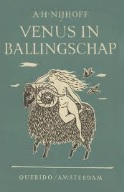 In 1954 Nijhoff moved back to the Antoinette house in Biggekerke, from where she regularly went to Lamorna to see Marlow Moss. A year later, her novel Venus in ballingschap (Venus in Exile) was published. The plot was again set in Cornwall and dealt with a woman who appears in a village and causes confusion there. Nijhoff made no secret that her themes and characters were based on reality.
In 1954 Nijhoff moved back to the Antoinette house in Biggekerke, from where she regularly went to Lamorna to see Marlow Moss. A year later, her novel Venus in ballingschap (Venus in Exile) was published. The plot was again set in Cornwall and dealt with a woman who appears in a village and causes confusion there. Nijhoff made no secret that her themes and characters were based on reality.
In 1958, Nijhoff suffered two strokes of fate at once: Both Marlow Moss and her mother died. She kept on caring for the recognition of Moss' works and lent them for exhibitions again and again.
At the end of the 1950s, Nijhoff rediscovered Greece for herself and lived there for a long time. The first time she had traveled there was in 1933 with Marlow Moss on the Orient Express. Now she resumed old contacts and planned to write a book about the country. However, it was not finished. In 1967, after the military coup there, she was once again forced to leave the country in which she lived; now, too, she moved back to the Netherlands.
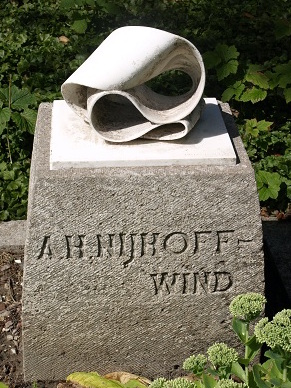 She spent the last two years of her life with her sister in The Hague. She died in the Red Cross Hospital there on May 22, 1971.
She spent the last two years of her life with her sister in The Hague. She died in the Red Cross Hospital there on May 22, 1971.
Her wish that her ashes be scattered in the sea like those of Marlow Moss could not be fulfilled, as this was forbidden in the Netherlands. She was then buried in the cemetery of Biggekerke. On her grave you can find a sculpture of Marlow Moss.
Text from 2019, translated with www.DeepL.com/Translator (free version), edited by Almut Nitzsche, June 2022.
Author: Doris Hermanns
Quotes
lt is difficult to draw a picture of the personality of this author, being as it is complex and yet simple, passionate and yet moderate, emotional and yet reasonable, idealistic and yet realistic, and it is only in reading her books the public will see a much fuller portrait of A. H. Nijhoff. In my opinion, A. H. Nijhoff will never be a prolific writer but, knowing her as well as I do, I take the liberty of saying that, when a book comes from her pen, every word of it has been lived.
(Marlow Moss)
If you hold the rights to one or more of the images on this page and object to its/their appearance here, please contact Fembio.


